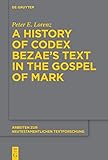A History of Codex Bezae’s Text in the Gospel of Mark / Peter E. Lorenz.
Material type: TextSeries: Arbeiten zur neutestamentlichen Textforschung ; 53Publisher: Berlin ; Boston : De Gruyter, [2021]Copyright date: ©2022Description: 1 online resource (XVI, 1013 p.)Content type:
TextSeries: Arbeiten zur neutestamentlichen Textforschung ; 53Publisher: Berlin ; Boston : De Gruyter, [2021]Copyright date: ©2022Description: 1 online resource (XVI, 1013 p.)Content type: - 9783110746051
- 9783110746938
- 9783110746860
- online - DeGruyter
- Issued also in print.
| Item type | Current library | Call number | URL | Status | Notes | Barcode | |
|---|---|---|---|---|---|---|---|
 eBook
eBook
|
Biblioteca "Angelicum" Pont. Univ. S.Tommaso d'Aquino Nuvola online | online - DeGruyter (Browse shelf(Opens below)) | Online access | Not for loan (Accesso limitato) | Accesso per gli utenti autorizzati / Access for authorized users | (dgr)9783110746860 |
Browsing Biblioteca "Angelicum" Pont. Univ. S.Tommaso d'Aquino shelves, Shelving location: Nuvola online Close shelf browser (Hides shelf browser)
Frontmatter -- Preface -- Acknowledgments -- Contents -- Introduction -- Chapter A: The Date of Codex Bezae’s Greek Text -- Chapter 2: Codex Bezae’s Greek Text and the Latin Version -- Chapter 3: Greek-Latin Bilingualism in Codex Bezae’s Production Context -- Chapter 4: Modeling Textual Change in the Development of Codex Bezae’s Greek Text -- Chapter 5: The Production Context of Codex Bezae’s Text of Mark -- Chapter 6: The Latin Layer of Codex Bezae’s Greek Text of Mark -- Chapter 7: Codex Bezae’s Text of Mark and the Greek Tradition -- Chapter 8: Towards a Textual History of Codex Bezae in Mark -- Appendix 1: List of Witnesses -- Appendix 2: Classification of Greek Witnesses in Mark -- Bibliography of Works Cited -- Index of Ancient Works -- General Index
restricted access online access with authorization star
http://purl.org/coar/access_right/c_16ec
As the principal Greek witness of the so-called "Western" tradition of the gospels and Acts, Codex Bezae’s enigmatic text in parallel Greek and Latin columns presents a persistent problem of New Testament textual criticism. The present study challenges the traditional view that this text represents a vivid retelling of the canonical narratives cited by ancient writers from Justin Martyr to Marcion and translated early into Syriac and Latin.
Using a combination of text-critical, church-historical, philological, and digital methods, the present study calls into question traditional assumptions about Codex Bezae’s distinctive Greek text of the gospels and Acts — that it represents an ancient native Greek tradition and source of the Latin version preserving a textual relic of the first century of Christianity — arguing that this text can be credibly dated to the end of the fourth century, immediately preceding production of the manuscript, and represents the diorthosis of a Greek text to a Latin model distinct from the Latin column found in the manuscript itself. So the better part of this remarkable text derives ultimately from other traditions and, hence, its true significance lies in what it can tell us about the historical circumstances under which the manuscript and its final text were produced at the turn of the fifth century.
Issued also in print.
Mode of access: Internet via World Wide Web.
In English.
Description based on online resource; title from PDF title page (publisher's Web site, viewed 02. Mai 2023)









